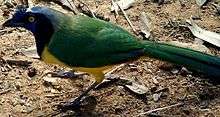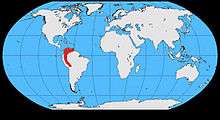Inca jay
| Inca jay | |
|---|---|
 | |
| Scientific classification | |
| Kingdom: | Animalia |
| Phylum: | Chordata |
| Class: | Aves |
| Order: | Passeriformes |
| Family: | Corvidae |
| Genus: | Cyanocorax |
| Species: | C. yncas |
| Binomial name | |
| Cyanocorax yncas (Boddaert, 1783) | |
 | |
The Inca jay (Cyanocorax yncas) is a bird species of the New World jays, which is endemic to the Andes of South America.
Taxonomy
Some ornithologists treat the green jay of North America and the Inca jay as conspecific and with C. yncas luxuosus as the green jay and C. yncas yncas as the Inca jay.[2][3]
Description

29.5–34.3 cm (11.6–13.5 in). The crown can appear mostly white, with blue limited to the frontal crest and nape. A black bib forms a broad band up to the sides of the head as well as a stripe through the eye line and one above it. The breast and underparts typically are bright yellow. The upper parts are rich green. It has large nasal bristles that form a distinct tuft in some subspecies, but are less developed in others. The color of the iris is bright yellow.
Breeding
Inca jays usually build a nest in a tree or in a thorny bush or thicket, and the female lays three to five eggs. Only the female incubates, but both parents take care of the young. In Colombia, Inca jays are recorded as retaining offspring for several years, and those young help the parents raise more chicks.[4] In Venezuela, they have been observed being victims of nest parasitism by giant cowbirds.
Feeding
Their basic diet consists of arthropods, vertebrates, seeds, and fruit.
Voice
As with most of the typical jays, this species has a very extensive voice repertoire. The bird's most common call makes a rassh-rassh-rassh sound, but many other unusual notes also occur. One of the most distinctive calls sounds like an alarm bell.
Distribution and habitat
The range extends southwards in the Andes from the Colombia and Venezuela through Ecuador, Peru, and Bolivia.
References
- ↑ BirdLife International (2012). "Cyanocorax yncas". IUCN Red List of Threatened Species. Version 2013.2. International Union for Conservation of Nature. Retrieved 26 November 2013.
- ↑ dos Anjos, L. (2018). del Hoyo, J.; Elliott, A.; Sargatal, J.; Christie, D.A.; de Juana, E., eds. "Green Jay (Cyanocorax yncas)". Handbook of the Birds of the World Alive. Lynx Edicions. Retrieved 16 May 2018. (Subscription required (help)).
- ↑ Dickinson, E.C.; Christidis, L., eds. (2014). The Howard & Moore Complete Checklist of the Birds of the World. Volume 2: Passerines (4th ed.). Eastbourne, UK: Aves Press. pp. 240–241. ISBN 978-0-9568611-2-2.
- ↑ Green Jay, Life History, All About Birds – Cornell Lab of Ornithology. Allaboutbirds.org. Retrieved on 2013-03-30.
External links
| Wikimedia Commons has media related to Cyanocorax yncas. |
- Green Jay videos on the Internet Bird Collection
- Stamps (for Belize, Venezuela) (shows RangeMap)
- Green Jay photo gallery VIREO
